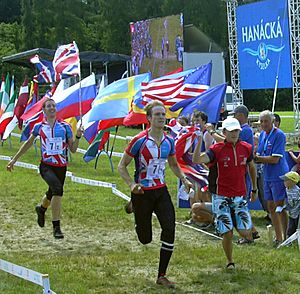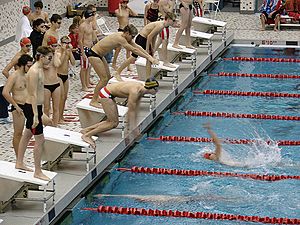Relay race facts for kids
A relay race is a fun and exciting team competition. In a relay, members of a team work together to complete a race. Each person takes a turn doing a part of the racecourse. It's all about teamwork and passing something, like a baton, to the next teammate.
Relay races are popular in many sports. You can find them in running, swimming, cross-country skiing, and even ice skating. In the Olympic Games, relay races are a big part of track and field. Teams usually have four members. Each member runs one section, called a "leg," of the race. The runner finishing their leg passes a special stick, called a "baton," to the next runner. This pass happens in a special area called an "exchange zone." In most relays, all team members run the same distance. For example, Olympic running relays are 400 meters (4 × 100 meters) and 1,600 meters (4 × 400 meters). Sometimes, in "medley relays," athletes run different distances.
Contents
Swimming Relays: Teamwork in the Water
Swimming relays are thrilling to watch! A team of four swimmers works together. A common strategy is for the second-fastest swimmer to go first, then the third-fastest, then the slowest, and finally the fastest swimmer (called the "anchor").
Swimmers in a relay can get a special boost. The next swimmer can start moving before their teammate touches the wall. This helps them save time, often 0.6 to 1.0 seconds! Also, many swimmers perform even better in a relay because of the team spirit. This means relay times are usually 2-3 seconds faster than if each swimmer raced alone.
Medley Swimming Relays
In a medley swimming relay, each swimmer uses a different stroke. The order is always: backstroke, breaststroke, butterfly, and then freestyle. The freestyle swimmer can't use any of the first three strokes. Most freestyle swimmers use the fast front crawl stroke.
The main swimming relays at the Olympics are the 4 × 100 meter freestyle relay, the 4 × 200 meter freestyle relay, and the 4 × 100 meter medley relay.
Mixed-gender relays, where teams have both male and female swimmers, became popular in 2014. They were added to the Olympics in 2020. Even in open water swimming, mixed-gender relays started in 2011.
Athletics Relays: Speed and Strategy
In track and field, the most common relays are the 4 × 100 metres relay and the 4 × 400 metres relay. Other distances like 4 × 200 meters and 4 × 1500 meters also exist. Mixed-gender 4 × 400 meter relays were first seen in 2017 and were added to the Olympics in 2020.
The 4 × 400 meter relay final is often the last event at a track meet. It's usually very exciting, especially if the race is close at the end! In these races, runners start accelerating before they get the baton. This means their individual times in a relay can be a bit faster than if they ran the distance alone.
Rules for Baton Passing
Each runner must pass the baton to their teammate within a special "exchange zone." These zones are marked on the track. In fast "sprint" relays, runners often use a "blind handoff." The next runner starts running when the first runner reaches a certain spot. They hold their hand back, and the first runner places the baton in it. Sometimes, the runner passing the baton will shout "Stick!" to let their teammate know it's coming. For longer relays, runners might jog while looking back to take the baton.
Why a Team Might Be Disqualified
A team can be disqualified from a relay for a few reasons:
- Not passing the baton inside the exchange zone.
- Starting too early (a false start).
- Getting in the way of another runner.
Team Strategy in Relays
For a four-person relay team, the usual strategy is to have the second-fastest runner go first. Then the third-fastest, followed by the slowest, and finally the fastest runner (the "anchor"). However, if a runner is really good at starting from the blocks, they might run the first leg. This is because the first leg is the only one that uses starting blocks.
Big Relay Competitions
One of the biggest relay events in the world is the Holmenkollstafetten in Norway. In 2014, it had over 2,900 teams and more than 44,000 competitors!
The Penn Relays in the USA is another huge event. It brings together over 15,000 athletes from high school, college, and professional levels. It's famous for making relay racing very popular in track and field.
Long-Distance Relays
Long-distance relays are becoming very popular. These races can have many legs, from 5 to 36, with each leg usually 5 to 10 kilometers long. Some are even 16 kilometers!
The world's longest relay race was Japan's Prince Takamatsu Cup Nishinippon Round-Kyūshū Ekiden. It was an amazing 1,064 kilometers long!
Cross-Country Relays
In cross-country skiing, a mixed relay race was added to the World Cross Country Championships in 2017.
There are also fun cross-country relay races designed to get runners excited about the sport. For example, in a "Crusader Team Sprint Cross Country Relay," teams of two runners complete four loops of a 1-mile course. Runner "A" runs loop 1, passes to "B," "B" runs loop 2, passes back to "A," and so on.
Shuttle Hurdle Relay
The Shuttle hurdle relay is a unique race where runners jump over hurdles. A mixed version was introduced in 2019. In this race, two men and two women on each team run a 110-meter hurdles course.
Medley Relay Events
Medley relay events are also held in track meets. These usually have four runners covering different distances. The distance medley relay has legs of 1200, 400, 800, and 1,600 meters. The sprint medley relay often has legs of 400, 200, 200, and 800 meters.
Relays on Coins
Relay races have even been featured on special collector's coins! For example, Greece minted a €10 coin in 2003 to celebrate the 2004 Summer Olympics. It shows modern athletes running with batons and also ancient athletes running a long race called the dolichos.
Relays in Skiing: Winter Team Sports
Cross-Country Skiing Relays
The FIS Nordic World Ski Championships has featured a relay race for men since 1933 and for women since 1954. Each team has four skiers. Men ski 10 kilometers each, and women ski 5 kilometers each.
Biathlon Relays
In biathlon, which combines cross-country skiing and rifle shooting, relay races are also popular. Teams have four biathletes. Each person skis 7.5 kilometers (men) or 6.0 kilometers (women). They also have two shooting rounds: one lying down (prone) and one standing up.
A mixed biathlon relay race, with both male and female athletes, was first held in 2005 and became an Olympic event in 2014.
Relays in Orienteering: Map and Compass Races
Orienteering is a sport where you use a map and compass to find your way. There are two very famous orienteering relays:
- Tiomila in Sweden (April/May)
- Jukola and Venla relay in Finland (June)
Other relays happen in the autumn, often with rules about the age and gender of the team members.
Other Exciting Relays
Triathlon Relays
The World Triathlon Mixed Relay Championships is a mixed-gender relay race that started in 2009. In a triathlon, each competitor has to do a segment of swimming, cycling, and running. This event was also added to the Olympics in 2020.
Cycling Relays
The madison is a track cycling event for two riders. They take turns racing, and they can switch at any time by touching their partner's hand. This event has been part of the World Championships since 1995 and the Olympics since 2000.
See also
 In Spanish: Carreras de relevos para niños
In Spanish: Carreras de relevos para niños
- 4 × 100 metres relay
- 4 × 400 metres relay
- Anchor leg
- Ekiden
- Relay (disambiguation)
- River to River Relay








